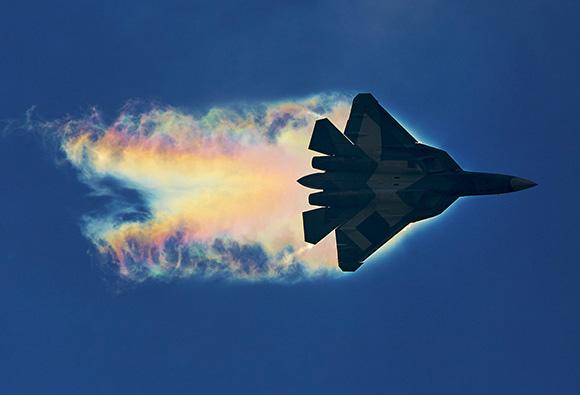The fifth-generation Sukhoi T-50 fighter has successfully completed release tests from weapons bay. For the first time, some weapon systems housed in the internal hold of the PAK-FA have been dropped. The announcement was made by General Vladimir Mikhailov, a former commander of the Russian Aerospace Forces. No other details were disclosed.
Three of the five PAK-FA prototypes are currently in the Akhtubinsk test center, at the Ministry of Defense, specializing in testing mission systems. The T-50-3, the T-50-4 and the T-50-5R are registered. The latter is the only PAK-FA to have been equipped with radar and sensors targeting. The T-50-1 and T-50-2 prototypes are located in Zhukovsky, near Moscow, to carry out various external load tests. A sixth prototype, belonging to the second experimental batch and implementing significant changes to the structure, should leave the Komsomolsk-on-Amur plants by April.
The last known incident of a T-50 dates back to the 10 June of the 2014, when one of the two engines of the fifth prototype caught fire. From Sukhoi they had to suspend the production of the sixth prototype and use the components already made to repair the damaged aircraft. The Russians pay the inexperience with the fifth generation technology, like the integration between the different sensors and the approach with the new coating stealth of which the Pak-Fa is equipped.
When the development of the PAK-FA is completed one day, Moscow will have a formidable fighter. The design is probably quite sophisticated if not similar in performance to that of the F-22 Raptor. If it can be even higher this is all to be demonstrated.
 The Sukhoi T-50 took to the air for the first time the 29 January of 2010 (photo on the right), devoid of part of the avionics such as radar and arms management systems. For the T-50, an operating cycle of forty years is expected, with an estimated cost of 100 million dollars per hunt. All fighters should be equipped with AESA radars and three-dimensional vector thrust control.
The Sukhoi T-50 took to the air for the first time the 29 January of 2010 (photo on the right), devoid of part of the avionics such as radar and arms management systems. For the T-50, an operating cycle of forty years is expected, with an estimated cost of 100 million dollars per hunt. All fighters should be equipped with AESA radars and three-dimensional vector thrust control.
Unlike the new American doctrine that for the 20 century considers "out-of-date" the close fighting, hypothesizing exclusively duels beyond the visual ray, for the Russians the dogfight it will still be the protagonist, that's why the T-50 will have every type of weapon necessary to impose its domain in every operating theater and at any distance. The Vympel R-73 appears in the arsenal (codename born: AA-11 Archer), a third generation infrared heat-guided air-to-air missile with a maximum range of 19 miles, approximately 30 km.
Despite a series production announced in the 2017 (it could be delayed by two years), the Russian Air Force has reduced the order of sixty T-50 to a dozen platforms with implemented changes. The Russians have increased the production of Su-30 and Su-35 fighters.
(photo: web / Sukhoi)












